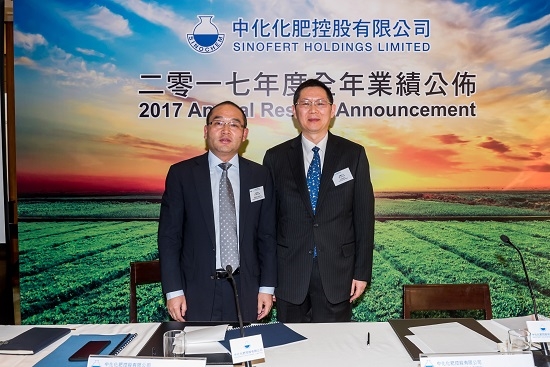
2017 Annual Results Highlights:
|
● Turnover grew 18% year-on-year to RMB17.644 billion.
● Loss attributable to the Company’s shareholders was substantially cut by RMB2.428 billion to RMB2.208 billion.
● The Group pursued strategic transformation and organizational restructuring, striving to become the leading fertilizer technical service provider and distributor in China.
|
(28 March 2018, Hong Kong) Sinofert Holdings Limited ("Sinofert" or the "Company", together with its subsidiaries collectively known as the "Group") (stock code: 00297) announced the annual results for the twelve months ended 31 December 2017 (the "Period"). During the Period, the Group implemented various measures to firmly capture market opportunities and recorded turnover of RMB17.644 billion, representing an 18% growth from a year ago. Meanwhile, the loss attributable to the Company’s shareholders was substantially cut by RMB2.428 billion to RMB2.208 billion. If the impacts of major non-recurring expenses and loss were excluded, the loss attributable to the Company’s shareholders would be RMB380 million.
During the Period, competition in the fertilizer industry was intense as the supply glut remained unsolved and both of exports and imports remarkably declined. On the other hand, obsolete production facilities were gradually eliminated and high-quality facilities thrived as the government vigorously promoted supply-side reform and agricultural transformation. While the industrial upgrading and reform posed opportunities and challenges to the fertilizer sector, the Group further deepened strategic transformation and organizational restructuring, striving to become the leading fertilizer technical service provider and distributor in China.
The Group carried out internal organizational restructuring and set up Basic Fertilizer Division to integrate its straight fertilizer business. Meanwhile, all agricultural fertilizers were operated by Distribution Division and all business units responsible for the distribution of agricultural fertilizers were completely separated from those responsible for the distribution of basic fertilizers. Specific marketing channels were developed for different targeted markets. After completion of the strategic adjustment, the Group’s operations were regrouped into three segments: Basic Fertilizer Division, Distribution Division and Production Division.
Basic Fertilizer Division generated revenue of RMB11.183 billion in the Period, representing a 14% year-on-year growth. Distribution Division generated revenue of RMB4.534 billion, up 21% from a year ago. Production Division generated revenue of RMB1.927 billion, representing a 35% year-on-year increase.
During the Period, revenue from the sale of potash fertilizers amounted to RMB3.905 billion, up 8% year-on-year. Revenues from the sale of nitrogenous fertilizers and compound fertilizers were RMB3.573 billion and RMB4.823 billion respectively, representing a 37% and 21% year-on-year growth respectively. Meanwhile, revenue from the sale of phosphate fertilizers was RMB3.574 billion, up 6% from a year ago; while revenue from the sale of MCP/DCP was RMB777 million and stayed flat when compared with 2016.
Basic Fertilizer Division attached great importance to core suppliers. It fully implemented strategic procurement strategy to further reduce procurement costs of basic fertilizers through direct-sale system. Besides, it stepped up direct sales efforts to big customers. As a result, the pre-tax revenue from this segment remarkably grew to RMB579 million. As for Distribution Division, the Group reinforced the platform for channel distribution and recruited agronomists to provide technical services in agricultural production. Based on the detailed customer segmentation, the Group fully implementedthe DTS channels strategy (in-depth distribution channel, technical marketing channel and selling channel for big customers). Production Division improved its operating results by strengthening management, reducing costs, enhancing operating efficiency, expanding marketing channels and innovating its logistic model. Meanwhile, the Group made persistent efforts to improve the operations of the enterprises it invested or controlled and completed the disposal of its equity interest in Qinghai Salt Lake.
Looking ahead, Mr. Qin Hengde, Executive Director and Chief Executive Officer of Sinofert, commented, "According to its No.1 Document released this year, the central government has formulated a comprehensive strategy to boost the economic development in rural areas. This creates invaluable opportunities for the Group to innovate its operations and deepen its transformation. In coherent with the government’s strategy to boost rural economies, the Group will capture the opportunities brought about by the supply-side structural reform and fast-changing environment in the agricultural sector to upgrade its businesses and promote modern agriculture. At the same time, the Group will optimize its business structure and innovate its business model to ensure its sustainable growth."
Mr. Qin Hengde said, "The Group will further enhance its distribution channels. As for Basic Fertilizer Division, it will reinforce the core supplier system, enhance the strategic procurement model and expand regional marketing to strengthen its marketing capability. As to the distribution of agricultural fertilizers, it will integrate the efforts in brand building, product mix optimization and marketing strategy management, thereby continuously improving its product mix. At the same time, the Group will continue to pursue DTS channel strategy, compress the marketing channels and actively explore a new business model for the development of modern agricultural platform for cash crops, thereby delivering direct services for large-scale farms. Meanwhile, the Group will step up R&D efforts, reinforce its technological capabilities and improve the overall management standards of its production units. It will strive hard to reduce costs and enhance the operating efficiency, accelerate the business restructuring and strengthen its risk and safety management.”